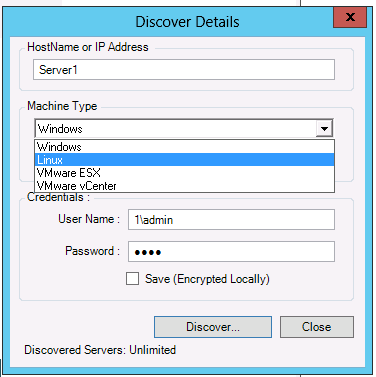19.4 Discovering Details for Target Containers
Before you configure a migration job, you must discover and perform an inventory of the target container. The inventory collects information about the host platform and its resources, such as the amount of RAM, number of cores and processors, datastores, networks, and resource groups.
19.4.1 Target Discovery in the Migrate Client
In Migrate Client, you can discover:
-
An individual virtual machine host server
-
Multiple virtual machine host servers
-
All VMware ESX hosts affiliated with a VMware vCenter Server
-
Hyper-V hosts
Before you begin discovery operations, ensure that PlateSpin Server can communicate with your source workloads and targets. See Section 2.6.1, Requirements for Discovery.
To discover targets using Migrate Client:
-
In the Migrate Client toolbar, click Discover Details.
or
In the Servers view, right-click in a blank area, then select Discover Details.
-
In the Discover Details dialog box, type the host name or IP address of the target.
To discover multiple machines, specify multiple host names or IP addresses separated by semicolons. If the target is behind a NAT device, specify its public (external) IP address.
See Migrations Across Public and Private Networks through NAT.

-
Select the machine type for the target container. If you select VMware vCenter, also provide the name of the vCenter cluster.
-
Windows
-
Linux
-
VMware ESX
-
VMware vCenter
-
Microsoft Hyper-V
See Discovery Guidelines for Target Hosts.
Discovering hosts with Xen hypervisor systems results in these systems being registered as PlateSpin Migrate source workloads (as opposed to VM host targets). For information about using these platforms as workload migration targets, see Migration to Virtual Machines on Xen.
-
-
Provide administrator credentials for the machine you are discovering.
-
(Optional) If you want to store these credentials for use during future jobs, enable the Save (Encrypted Locally) option.
-
Click Discover and wait for the process to complete.
-
(Optional) If you want to monitor the progress of the job, switch to the Jobs view.
19.4.2 Target Discovery in the Web Interface
To migrate a workload through the Web Interface, you must first add or discover the intended target container and its resources.
PlateSpin Migrate Web Interface supports discovery of virtual and cloud target containers:
-
Microsoft Azure Location
-
VMware vCloud Organization
-
VMware DRS Cluster
-
VMware ESX Server
When you add the target, its associated resources are automatically discovered. You can add one container at a time. All available target containers are listed on the Targets page.
Before you begin discovery operations, ensure that PlateSpin Server can communicate with your source workloads and targets. See section Section 2.6.1, Requirements for Discovery.
To add a target container:
-
In the Migrate Web Interface, click Targets > Add Target.
-
Select one of the following target types:
-
Microsoft Azure Location
-
VMware DRS Cluster
-
VMware ESX Server
-
VMware vCloud Organization
-
-
Depending on the type of targets you selected in the previous step, specify the appropriate access information.
-
Microsoft Azure Location: See Table 19-4.
For more information about the options for Microsoft Azure Location, see the white paper
Best Practices for Migrating Servers to Microsoft Azure with PlateSpin Migrate
on the PlateSpin Migrate Resources web page. -
VMware DRS Cluster: See Table 19-5.
-
VMware ESX Server: See Table 19-6.
-
VMware vCloud Organization: See Table 19-7.
Table 19-4 Options for Microsoft Azure Location Target
Option
Description
Subscription Id
Specify the subscription ID for your Microsoft Azure account.
Application Id
Specify your Azure Application ID required to enable PlateSpin Migrate to use the Azure APIs when it replicates or migrates workloads on your behalf to VMs in the target Azure account.
Username and Password
Specify administrator-level credentials for accessing the parent Microsoft Azure account.
Location Name
Select the location for the Microsoft Azure target.
Click Update Location List to refresh the list of available locations in the menu.
Locations are now sorted by the geographical region and alphabetically. The mapping is fixed and is based on the current categories that Azure uses. If Microsoft Azure adds new regions after the current release, Migrate displays them dynamically and alphabetically in the Recently Added category.
Table 19-5 Options for VMware DRS Cluster Target
Option
Description
vCenter Hostname or IP
Specify the host name or IP address of the vCenter server.
Cluster Name
Specify the name of the DRS cluster. This is applicable only for VMware DRS Cluster.
Username and Password
Specify administrator-level credentials for accessing the target host.
Table 19-6 Options for VMware ESX Server Target
Option
Description
Hostname or IP
Specify the host name or IP address of the VMware ESX server.
Username and Password
Specify administrator-level credentials for accessing the target host.
Table 19-7 Options for VMware vCloud Organization Target
Option
Description
vCloud Director Server Address
Specify the server host name or the IP address of the vCloud Director server.
For example: cloud.example.com or 10.10.10.101
Organization Name
Specify the name of the organization in the vCloud Director server. The name is case sensitive in vCloud. Type the name exactly as you created it.
For example: DemoOrg001
Username and Password
Specify the organization-level administrator credentials for accessing the target host.
For example: demouser1 and demopwd
-
-
Click Test Credentials to validate the credential values you specified.
-
Click Add to add and discover details about the target and list it on the Targets page.